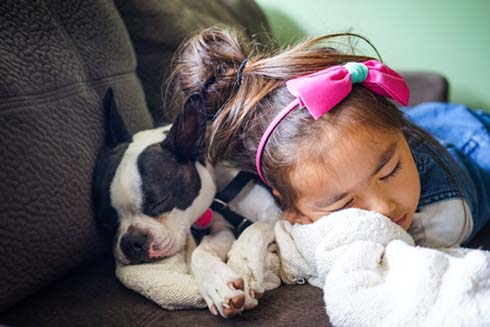Dog Bites Child – Can it Ever be Trusted?
The Cleavers’ Boston
Visiting the Grahams was always exciting although, in retrospect, it was pretty ordinary. Kenny Graham was a funny kid, the same age as my big sister Martha. Their family was like June, Ward, and Beaver Cleaver. Life was simple. I was 4 years old; Martha was 6 – average baby boomer kids. I thought the Graham family was really lucky because they had a dog, a black and white Boston terrier named Buster. I loved Buster and I was sure he loved me back. We didn’t have pets.
One day the grown-ups were playing cards and drinking tea. I was on the floor when I spied Buster camped out under the table. He sure was cute. I could tell right away that he was inviting me to creep up to him for a bit of snuggling. I happily accepted. Rushing in on all 4s to hug the object of my affection I was startled by a quick snarl and was then summarily bitten on the face.
Surprise could hardly describe my emotions; that dog was lightning fast. Despite my overwhelming sense of betrayal, there was nothing unusual about what happened. Rude awakenings to the realities of canine behavior occur somewhere every day. I understand this now because I’m a residency trained veterinary behaviorist.
Looking back at that pivotal moment I realize that I had completely misread the body signals that were veritably emanating from scared Buster, hiding out near his person’s feet. I remember the pinned back ears and straight-on glare as I delightedly advanced. His body signaling was loud and clear: “I’m freaked-out. I fear that you are going to hurt me, you homicidal nut job! I might perceive a threat and panic. I have a mouth full of teeth and I know how to use them!” As I, the child who assumed way too much, closed on Buster he issued his final, this time verbal, warning: “Grrr!!” Translation: “I will defend myself, to the end!” Which is, of course, exactly what he did.
Trapped Dog Bites Child while Adults Snooze
I was not scarred for life when Buster the Boston bit me but it was certainly an eye-opener on canine and human behavior. All 4 parents leapt out of their chairs like they’d been shot from canons. Fusillades of reprimands descended upon poor Buster, now cowering even deeper into his erstwhile hideaway. An immediate consequence was essential. Vicious dogs would not be tolerated! Solutions were bandied about like a ball in a free-for-all tennis match, emotion-driven remedies masquerading as informed logic bouncing off the walls. Give Buster away? Put him to sleep? It was overwhelming; I too was trying to get small. An ice pack to my cheek deescalated the crisis.
We’ve learned a lot about these child – dog debacles. In her seminal research paper, Behavioral characteristics associated with dog bites to children, Dr. Ilana Reisner found that, “Children are the most frequent victims of dog bites presenting to hospital emergency departments.” Of the 203 youngsters in this study, 51% were under age 7 years; 55% were male. The biting dog was known to 72% of the children. Most bites to younger kids occurred during positive interactions, initiated by the child with stationary, familiar dogs indoors. That sounds just like me and Buster.
It could be argued that my face bite was actually my fault, not Buster’s. So what could I have done differently? Gimme a break, would ya? I was only 4 years old. I hadn’t even started kindergarten. But if I knew then what I know now I would have taken a moment to observe before rushing in. Buster had sought safety in a snug, secluded den-like space next to his person’s feet. As this marauding 4-year-old advanced, the poor dog was stuck in a corner with no escape. His fearful signals could have/should have been respected.
Buster’s people weren’t paying attention. They thought their dog was trustworthy with kids. Clearly, I wasn’t the only knucklehead; the grown-ups didn’t have a clue either. Well, we know what happens when we assume.
Move off the Grid? Learn Dog-Speak Instead
Fear is the driving force in nearly all dog bites to humans. Really? Fear of a toddler or preschooler? Don’t bother trying to apply human logic to a split-second canine reaction. Dogs think differently. They share many social traits with us but they are members of a different species, not little people in furry suits.
Instead of taking up residence in a human domicile Buster the Boston terrier could have lived in a feral canine social group. (Dogs, by the way, don’t live in packs. Wolves do.) Like others of his ilk he would be free of unnatural constraints like walls and furniture. Had I invaded his personal space he would not have felt trapped and bitten my face. He would have bolted and run far enough to feel safe from this @#%&* slobbering 4 year old.
The simple way for the grownups to set this jittery terrier up for success would have been to sit cross-legged on the ground in a big open field as they played their raucous game of bridge. As I delightedly approached the round-headed object of my delight he would have sprinted for the next county. Sadly, hemmed in by walls and furniture, he had no place to go. So, he panicked and snapped. Punishment would not have been the right treatment for his fear, nor would banishment from home and family.
Dogs communicate. Those who get wiggy around unfamiliar people might lean away. They may turn their heads while watching the scary monster with a “whale eye.” Also look for lip licking, yawning, and shaking off, as though they are wet. Some overwhelmed dogs bark and lunge.
Repeating these encounters, hoping a dog will get accustomed to strangers, is a formula for worsening the problem. The only safe management is to prevent the drama. Never let anyone approach, reach for, lean over, or stare at a dog who shows tension. Allow that nervous wreck to stay in another room with a food-dispensing toy while you party hearty elsewhere.
Child Student Teacher & Canine Pupil
When anybody feels trapped and panicked there’s an adrenaline surge that can trigger fight or flight, and maybe a bite. Avoid the whole debacle. Dogs who aren’t happy with guests should hang out some other place. Put a nervous pupster in another room prior to the arrival of visitors so she can relax away from the action until those alien creatures depart. Everybody’s boundaries should be respected, including nonhuman members of the group.
I was a fortunate 4 year old; Buster the Boston terrier could have inflicted a severe facial injury. The resulting abrasion bled slightly, which of course caused great parental alarm. I could have gotten rabies or tetanus or been permanently disfigured!!! Instead there was a lesson: compassion for a small dog who did not speak a human language. His brain’s synapses were firing fast as I invaded his under-the-card table hideout. He could have tried to run past me to escape but excitatory neurochemicals flooded his prefrontal cortex – the cognitive, decision making part of his brain. Logic was lost. The little guy just freaked-out and lashed-out to drive the threat away. It was not his fault.
Children can learn to set a dog up to succeed. You’ll make it fun by teaching them a game they can share with a nervous Nellie. Their 4-legged subordinate will be delighted to earn food and, if everybody’s calm, a bit of petting from their young leader. A budding dog trainer can be the boss of somebody else.
Adult and child will each wear their very own personal treat bags. Yours will be well-stocked with bits of cheese or hot dog but the kiddo’s should hold only one snack at-a-time. Stick a couple of pieces of duct tape on the floor where those pint-sized feet will park and then have the dog sit 8-10 feet in front. Standing hip-to-hip with your protégé, hold a treat and say, “Buster, Come!” Make it easy for the canine student to relax by squatting with your side turned and not staring directly at him. After he happily races to you to snag the treat you will leave your awe-struck child with her toes still on the tape while you return that pupster to his place. Then give your student teacher one treat for her moment in the limelight. She can call her dog and reinforce with food and remain in place while you return her pupil to his place for another round. It’s OK if the payoff takes a few tries; patience is another valuable lesson.
Buster the Boston did OK in the end. His family kept him out of the reach of children during our visits. But even dogs who are happy campers with all humans great and small should be carefully supervised with youngsters. There is so much that pets can help us pass along to the next generation about treating others well: Respect personal space, let sleeping dogs lie, and don’t steal their food.





